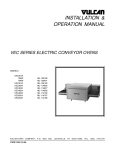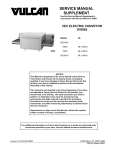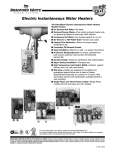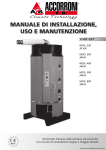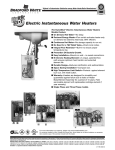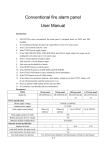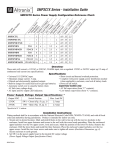Download Vulcan-Hart VEC4018 ML-126199 Service manual
Transcript
SERVICE MANUAL VEC CONVEYOR OVENS ELECTRIC CONVEYOR OVENS MODEL ML VEC3018 10KW 15KW 126198 126401 VEC4018 126199 VEC3624 114836 VEC3632 114837 VEC3624 SHOWN - NOTICE This Manual is prepared for the use of trained Vulcan Service Technicians and should not be used by those not properly qualified. If you have attended a Vulcan Service School for this product, you may be qualified to perform all the procedures described in this manual. This manual is not intended to be all encompassing. If you have not attended a Vulcan Service School for this product, you should read, in its entirety, the repair procedure you wish to perform to determine if you have the necessary tools, instruments and skills required to perform the procedure. Procedures for which you do not have the necessary tools, instruments and skills should be performed by a trained Vulcan Service Technician. Reproduction or other use of this Manual, without the express written consent of Vulcan, is prohibited. A product of VULCAN-HART Form 24641 (MARCH 1999) LOUISVILLE, KY 40201-0696 ELECTRIC CONVEYOR OVENS TABLE OF CONTENTS GENERAL . . . . . . . . . . . . . . . . . . . . . . . . . . . . . . . . . . . . . . . . . . . . . . . . . . . . . . . . . . . . . . . . . . . . . . . . . . . . . General . . . . . . . . . . . . . . . . . . . . . . . . . . . . . . . . . . . . . . . . . . . . . . . . . . . . . . . . . . . . . . . . . . . . . . . . . . . Installation . . . . . . . . . . . . . . . . . . . . . . . . . . . . . . . . . . . . . . . . . . . . . . . . . . . . . . . . . . . . . . . . . . . . . . . . . Operation . . . . . . . . . . . . . . . . . . . . . . . . . . . . . . . . . . . . . . . . . . . . . . . . . . . . . . . . . . . . . . . . . . . . . . . . . . Lubrication . . . . . . . . . . . . . . . . . . . . . . . . . . . . . . . . . . . . . . . . . . . . . . . . . . . . . . . . . . . . . . . . . . . . . . . . . Cleaning Procedures . . . . . . . . . . . . . . . . . . . . . . . . . . . . . . . . . . . . . . . . . . . . . . . . . . . . . . . . . . . . . . . . . Tools . . . . . . . . . . . . . . . . . . . . . . . . . . . . . . . . . . . . . . . . . . . . . . . . . . . . . . . . . . . . . . . . . . . . . . . . . . . . . Specifications . . . . . . . . . . . . . . . . . . . . . . . . . . . . . . . . . . . . . . . . . . . . . . . . . . . . . . . . . . . . . . . . . . . . . . 3 3 3 3 3 3 3 3 REMOVAL AND REPLACEMENT OF PARTS . . . . . . . . . . . . . . . . . . . . . . . . . . . . . . . . . . . . . . . . . . . . . . . . . 4 Covers and Panels . . . . . . . . . . . . . . . . . . . . . . . . . . . . . . . . . . . . . . . . . . . . . . . . . . . . . . . . . . . . . . . . . . . 4 Control Panel Components . . . . . . . . . . . . . . . . . . . . . . . . . . . . . . . . . . . . . . . . . . . . . . . . . . . . . . . . . . . . 4 Temperature Probe . . . . . . . . . . . . . . . . . . . . . . . . . . . . . . . . . . . . . . . . . . . . . . . . . . . . . . . . . . . . . . . . . . 4 Blower Motor . . . . . . . . . . . . . . . . . . . . . . . . . . . . . . . . . . . . . . . . . . . . . . . . . . . . . . . . . . . . . . . . . . . . . . . 5 High Limit Thermostat . . . . . . . . . . . . . . . . . . . . . . . . . . . . . . . . . . . . . . . . . . . . . . . . . . . . . . . . . . . . . . . . 6 Cooling Fans . . . . . . . . . . . . . . . . . . . . . . . . . . . . . . . . . . . . . . . . . . . . . . . . . . . . . . . . . . . . . . . . . . . . . . . 6 Conveyor Assembly/belt . . . . . . . . . . . . . . . . . . . . . . . . . . . . . . . . . . . . . . . . . . . . . . . . . . . . . . . . . . . . . . 6 Conveyor Belt Splicing . . . . . . . . . . . . . . . . . . . . . . . . . . . . . . . . . . . . . . . . . . . . . . . . . . . . . . . . . . . . . . . . 8 Conveyor Drive Motor . . . . . . . . . . . . . . . . . . . . . . . . . . . . . . . . . . . . . . . . . . . . . . . . . . . . . . . . . . . . . . . . 9 Conveyor Drive Chains . . . . . . . . . . . . . . . . . . . . . . . . . . . . . . . . . . . . . . . . . . . . . . . . . . . . . . . . . . . . . . . 9 Heat Elements . . . . . . . . . . . . . . . . . . . . . . . . . . . . . . . . . . . . . . . . . . . . . . . . . . . . . . . . . . . . . . . . . . . . . 10 SERVICE PROCEDURES AND ADJUSTMENTS . . . . . . . . . . . . . . . . . . . . . . . . . . . . . . . . . . . . . . . . . . . . . . 12 Blower Adjustment . . . . . . . . . . . . . . . . . . . . . . . . . . . . . . . . . . . . . . . . . . . . . . . . . . . . . . . . . . . . . . . . . . 12 Temperature Control Programming and Calibration . . . . . . . . . . . . . . . . . . . . . . . . . . . . . . . . . . . . . . . . . 12 Programming . . . . . . . . . . . . . . . . . . . . . . . . . . . . . . . . . . . . . . . . . . . . . . . . . . . . . . . . . . . . . . . . . 12 Calibration . . . . . . . . . . . . . . . . . . . . . . . . . . . . . . . . . . . . . . . . . . . . . . . . . . . . . . . . . . . . . . . . . . . . 12 Temperature Probe Test . . . . . . . . . . . . . . . . . . . . . . . . . . . . . . . . . . . . . . . . . . . . . . . . . . . . . . . . . . . . . 13 Air Distribution Adjustment . . . . . . . . . . . . . . . . . . . . . . . . . . . . . . . . . . . . . . . . . . . . . . . . . . . . . . . . . . . . 13 Drive Chain Tension . . . . . . . . . . . . . . . . . . . . . . . . . . . . . . . . . . . . . . . . . . . . . . . . . . . . . . . . . . . . . . . . 14 Conveyor Belt Tension . . . . . . . . . . . . . . . . . . . . . . . . . . . . . . . . . . . . . . . . . . . . . . . . . . . . . . . . . . . . . . . 15 Heat Element Test . . . . . . . . . . . . . . . . . . . . . . . . . . . . . . . . . . . . . . . . . . . . . . . . . . . . . . . . . . . . . . . . . . . . . . . . . . . . . . . . . . . . . . . . . 15 ELECTRICAL OPERATION . . . . . . . . . . . . . . . . . . . . . . . . . . . . . . . . . . . . . . . . . . . . . . . . . . . . . . . . . . . . . . Component Function . . . . . . . . . . . . . . . . . . . . . . . . . . . . . . . . . . . . . . . . . . . . . . . . . . . . . . . . . . . . . . . . Component Location . . . . . . . . . . . . . . . . . . . . . . . . . . . . . . . . . . . . . . . . . . . . . . . . . . . . . . . . . . . . . . . . Oven Sequence of Operation . . . . . . . . . . . . . . . . . . . . . . . . . . . . . . . . . . . . . . . . . . . . . . . . . . . . . . . . . . Schematic Diagram . . . . . . . . . . . . . . . . . . . . . . . . . . . . . . . . . . . . . . . . . . . . . . . . . . . . . . . . . . . . . . . . . Wiring Diagrams . . . . . . . . . . . . . . . . . . . . . . . . . . . . . . . . . . . . . . . . . . . . . . . . . . . . . . . . . . . . . . . . . . . 16 16 17 18 19 20 TROUBLESHOOTING . . . . . . . . . . . . . . . . . . . . . . . . . . . . . . . . . . . . . . . . . . . . . . . . . . . . . . . . . . . . . . . . . . 24 © VULCAN 1999 Page 2 of 24 ELECTRIC CONVEYOR OVENS - GENERAL GENERAL GENERAL SPECIFICATIONS Procedures in this manual will apply to all models unless specified. Pictures and illustrations can be of any model unless the picture or illustration needs to be model specific. INSTALLATION NOMINAL AMPS PER LINE WIRE MODEL 3018 Generally, installations are made by the dealer or others contracted by the dealer or owner. Detailed installation instructions are included in the "Instructions" manual which is sent with each unit. TOTAL KW 3 Phase 1 Phase 208V 240V 480V 208V 240V 10 28 24 12 48 42 15 42 36 18 72 63 4018 15 42 36 18 72 63 3624 30 83 72 36 144 125 3632 30 83 72 36 144 125 OPERATION Detailed operation instructions are included with each oven. LUBRICATION No lubrication is required. CLEANING PROCEDURES Detailed cleaning procedures are included in the "Instructions" manual for the appropriate model. TOOLS Standard Standard set of hand tools. VOM with A.C. current tester (Any quality VOM with a sensitivity of at least 20,000 ohms per volt can be used). Special Temperature tester (thermocouple type). Page 3 of 24 ELECTRIC CONVEYOR OVENS - REMOVAL AND REPLACEMENT OF PARTS REMOVAL AND REPLACEMENT OF PARTS COVERS AND PANELS CONTROL PANEL COMPONENTS WARNING: UNPLUG UNIT BEFORE SERVICING. Front Panel The following are located in the control panel: 1. Lift up on the panel handle. • Solid state relays. 2. Pull out on the bottom of the panel. • Transformer. 3. Reverse the procedure to install. • Power switch and pilot light. Air Distribution Panels • Speed control. 1. Remove the front panel as outlined under “COVERS AND PANELS”. • Temperature control. • Power supply module. 2. If removing the bottom air panel, remove the crumb tray. • Hi limit thermostat. 3. Pull the air distribution panel from the oven. 4. WARNING: UNPLUG UNIT BEFORE SERVICING. 1. Remove the control housing as outlined under "COVERS AND PANELS". 2. Remove the component. 3. Reverse the procedure to install the new component. 4. Check oven for proper operation. TEMPERATURE PROBE Reverse the procedure to install. Control Housing 1. Remove the top cover from the control housing. 2. Remove the back panel from the housing. 3. Unplug the lead wires to the control panel components. 4. Remove the remaining section of the control panel housing. 5. Reverse the procedure to install. WARNING: UNPLUG UNIT BEFORE SERVICING. Motor Housing 1. Remove the crumb trays from both ends of the conveyor belt. 2. Lift conveyor and move forward enough to remove drive chain from the conveyor belt driven gear. 3. Move the conveyor belt assembly away from the motor housing. 4. Remove the top cover and rear panel from the housing. 5. Remove the remaining section of the motor housing from the oven. 6. Reverse the procedure to install. 1. Remove the bottom air distribution panel as outlined under "COVERS AND PANELS". 2. Remove the clamp from the probe routing tube and spread the notches at the end of the tube. 3. Remove the probe from the routing tube. 4. Reverse the procedure to install the new probe. Page 4 of 24 ELECTRIC CONVEYOR OVENS - REMOVAL AND REPLACEMENT OF PARTS 5. Position the end of the probe as indicated in chart. MODEL DIMENSION “A” 3018 2-1/4" 9-1/4" 1/2" 4018 2-1/4" 10-5/8" 1/2" 3632 / 3624 1-3/4" 15-3/4" 1-3/16" 6. DIMENSION “B” A. Remove the nuts from the mounting studs. B. Push down on the rear of the motor to dislodge the front sheet metal shield from the slot in the air chamber. C. Pull the motor assembly from the air chamber. DIMENSION “C” Adjust the temperature control as outlined under "TEMPERATURE CONTROL PROGRAMMING AND CALIBRATION" in "SERVICE PROCEDURES AND ADJUSTMENTS". BLOWER MOTOR 4. Note the location of the blower on the motor shaft. 5. Loosen the set screws on the blower hub and remove the blower from the motor shaft. When installing, blower hub should be 1/8" from end of motor shaft. NOTE: One of the set screws must align with the flat on the motor shaft. 1. Remove the motor housing as outlined under “COVERS AND PANELS”. NOTE: If only the blower is being replaced, reverse procedure to install and check blower position as outlined under "BLOWER ADJUSTMENT" in "SERVICE PROCEDURES AND ADJUSTMENTS. 2. Disconnect the lead wires from the motor. 6. 3. Remove the motor assembly from the air chamber. Remove the shield and insulation from the motor shaft. 7. Remove the bolts from the motor mounting plate and remove the motor. 8. Reverse procedure to install. WARNING: UNPLUG UNIT BEFORE SERVICING. Page 5 of 24 ELECTRIC CONVEYOR OVENS - REMOVAL AND REPLACEMENT OF PARTS HIGH LIMIT THERMOSTAT COOLING FANS WARNING: UNPLUG UNIT BEFORE SERVICING. WARNING: UNPLUG UNIT BEFORE SERVICING. 1. Remove back panel from control housing. 1. 2. Pull off thermostat cover and remove screws securing thermostat to mounting bracket. Remove the rear motor housing panel if replacing that fan, or the rear control housing panel if replacing that fan. 3. For Models 3018 and 4018, loosen clamp screw and withdraw thermostat sensing bulb from tube. 2. Disconnect the lead wires from the cooling fan. 3. Remove the fan from the rear panel. 4. Reverse procedure to install. CONVEYOR ASSEMBLY/BELT WARNING: UNPLUG UNIT BEFORE SERVICING. 4. For other models, remove oven back panel and carefully take out insulation. 5. Remove high limit thermostat sensing bulb. 6. 1. Remove conveyor crumb trays. 2. Remove cover where conveyor drive shaft enters the motor housing. 3. Lift up the drive end of the conveyor assembly and slide the conveyor assembly into the oven tunnel to remove the tension on the drive chain. Then slip the drive chain off the conveyor drive sprocket. Reverse procedure to install. Page 6 of 24 ELECTRIC CONVEYOR OVENS - REMOVAL AND REPLACEMENT OF PARTS 4. Pull the entire conveyor assembly from the oven. 4. Remove splicing strands by unhooking ends and squeezing ends together and withdrawing thru link. 5. Assemble in reverse order. Adjust conveyor belt tension as outlined in “CONVEYOR BELT TENSION”. NOTE: Conveyor will need to be lifted so crumb tray slides will clear as assembly is pulled out. 5. To replace conveyor, reverse the procedure. Conveyor Belt 1. Remove conveyor assembly as outlined in ”CONVEYOR ASSEMBLY/BELT”. 2. Loosen belt tension screws at the end of the belt track. 3. Rotate belt manually until you locate the wide end-hooks of the splicing strands where the belt should disconnected. Page 7 of 24 ELECTRIC CONVEYOR OVENS - REMOVAL AND REPLACEMENT OF PARTS CONVEYOR BELT SPLICING Install the conveyor belt so that it always runs with the closed end of the loops in the direction of travel as indicated by arrow. NOTE: The arrows in the belt illustrate the movement of the splicing strand between steps. When bending the splicing strand, try to limit bending to straight portions of the strand rather than in the “Z” bend area. Splice one side completely before starting the other side. After completely splicing the belt, it is advisable to go along the width of the belt straightening the spliced-in strand. Depending on the width of the belt, there might be one, two, or three splicing strands. Page 8 of 24 ELECTRIC CONVEYOR OVENS - REMOVAL AND REPLACEMENT OF PARTS CONVEYOR DRIVE MOTOR CONVEYOR DRIVE CHAINS WARNING: UNPLUG UNIT BEFORE SERVICING. WARNING: UNPLUG UNIT BEFORE SERVICING. 1. Perform steps 1 thru 3 in “CONVEYOR DRIVE CHAINS”. 1. Remove the motor housing as outlined under “COVERS AND PANELS”. 2. Note location of sprocket on motor shaft and remove sprocket. 2. 3. Remove socket head screws securing motor and remove motor. Remove motor drive chain by loosening nut on large driven gear shaft. Raise gear and remove chain. 3. Install in reverse order and adjust chain tension as outlined in “DRIVE CHAIN TENSION”. 4. Install in reverse order and adjust chain tension as outlined in “DRIVE CHAIN TENSION”. Page 9 of 24 ELECTRIC CONVEYOR OVENS - REMOVAL AND REPLACEMENT OF PARTS HEAT ELEMENTS 4. Identify and remove power leads from elements. 5. Remove screws securing heater assembly. 6. Carefully pull heater assembly out of chamber. 7. Replace elements. WARNING: UNPLUG UNIT BEFORE SERVICING. 1. Remove the control housing as outlined under “COVERS AND PANELS”. Models 3018 and 4018 1. Remove two screws securing component mounting assembly. 2. Swing out component mount assembly. 3. Remove insulation and cover. Carefully work element wires out of the cutout in cover. Page 10 of 24 ELECTRIC CONVEYOR OVENS - REMOVAL AND REPLACEMENT OF PARTS Models 3624 and 3632 WARNING: UNPLUG UNIT BEFORE SERVICING. 1. Remove the control housing as outlined under “COVERS AND PANELS”. 2. Remove oven back panel and insulation. 3. Remove high limit thermostat sensing bulb. 4. Identify and remove bottom wires. 5. Remove inside panel. 6. Carefully pull out element tray. 7. Replace elements. 8. Reverse procedure to install. Page 11 of 24 ELECTRIC CONVEYOR OVENS - SERVICE PROCEDURES AND ADJUSTMENTS SERVICE PROCEDURES AND ADJUSTMENTS WARNING: CERTAIN PROCEDURES IN THIS SECTION REQUIRE ELECTRICAL TEST OR MEASUREMENTS WHILE POWER IS APPLIED TO THE MACHINE. EXERCISE EXTREME CAUTION AT ALL TIMES. IF TEST POINTS ARE NOT EASILY ACCESSIBLE, DISCONNECT POWER, ATTACH TEST EQUIPMENT AND REAPPLY POWER TO TEST. 7. BLOWER ADJUSTMENT WARNING: UNPLUG UNIT BEFORE SERVICING. 1. Remove the blower motor and mounting assembly by following steps 1 thru 4 as outlined under "BLOWER MOTOR" in “REMOVAL AND REPLACEMENT OF PARTS”. Press either arrow key until the display shows “H”. This sets unit to use a “K” type thermocouple and must be used. NOTE: “J” in the display sets unit for use with a “J” type thermocouple. Do not use this setting. 8. Press “S”. 9. Press either arrow key until the display shows “oF” for °F read-out or “oC” for °C read-out. 2. Loosen the motor mounting bolts. 10. Press “S”. 3. Adjust the motor position until the blower is parallel to the motor mounting plate. 11. Press either arrow key until the display shows “nD”. This sets unit for normally de-energized output relay and must be used. CAUTION: Ensure that the blower does not hit the heat exchanger. 4. Tighten motor mounting bolts. 12. Press “S”. NOTE: If the top and bottom of the blower are not parallel to the motor mounting plate, shims should be placed between the motor and the mounting plate. 5. 13. Press either arrow key until the display shows “FO”. This sets unit for thermostat on and must be used. 14. Press “S”. Reverse the procedure to install. TEMPERATURE CONTROL PROGRAMMING AND CALIBRATION 15. Press either arrow key until the display shows “HE”. This sets unit for heating mode and must be used. 16. Press “S”. 17. Press either arrow key until the display shows “H5”. This set unit for thermostat cycle time delay and must be used. 18. Press “S” repeatedly to until the normal temperature display is shown. Programming NOTE: During programming, after 15 seconds of no activity, the controller will automatically save the settings and return to the temperature display. 1. Turn the power switch off. 2. Press and hold down “S” key on the control. 3. Turn the power switch on. “PrG” will appear on the display. 4. Release the “S” key and “PO” will appear on the display. 5. Press either arrow key until “P85" appears on the display. NOTE: P85 must be displayed. It is the only entry applicable to these units. 6. NOTE: If “nE” is selected it sets unit for normally energized output relay and oven will not operate. Calibration NOTE: During programming, after 15 seconds of no activity, the controller will automatically save the settings and return to the temperature display. This procedure sets the temperature control to agree with actual cavity temperature. 1. Position temperature tester probe in center of oven cavity. 2. Turn oven on. 3. Set oven temperature control to 500(F set point temperature. Press “S”. Page 12 of 24 ELECTRIC CONVEYOR OVENS - SERVICE PROCEDURES AND ADJUSTMENTS A. This is done by holding the “S” key in while pressing the arrow keys to raise or lower the temperature. Otherwise the display shows the current measured temperature. 4. Allow the heat to stabilize at the set point. The heat should be occasionally turning off and on. 5. Subtract the temperature tester measured value from 500 and write down the subtracted value. This is the offset value that will be entered into the controller soon. 6. Turn the power off at the oven. 7. Press and hold down “S” key on the control. 8. Turn the power switch on. “PrG” will appear on the display. 9. Release the “S” key and “PO” will appear on the display. 5. Test the probe with an ohmmeter. TEMP (F 77 240 260 280 300 320 340 6 ±10% 90000 4077 3016 2266 1726 1332 1041 TEMP (F 360 380 400 425 450 475 6 ±10% 822 656 529 424 334 266 AIR DISTRIBUTION ADJUSTMENT WARNING: UNPLUG UNIT BEFORE SERVICING. 1. Remove the air distribution panel that needs adjusted as outlined under “COVERS AND PANELS” in “REMOVAL AND REPLACEMENT OF PARTS”. 2. 11. Press “S” repeatedly until the display shows “Co1”. (indicates differential between actual temperature and display temperature) Adjust the panels as outlined below under “TOP PANEL” and “BOTTOM PANEL”. 3. Reverse procedure to install. NOTE: “Co1" only displays for a few seconds then changes to display the value. 1. 10. Press either arrow key until “P85" appears on the display. NOTE: P85 must be displayed. It is the only entry applicable to these units. Top Panel 12. Press either arrow key to change the displayed value to read the subtracted value obtained in step 5. If baking is even, but more or less air is required on the top of the product. A. Adjust the air volume screw. B. Turn the screw clockwise for more air and counterclockwise for less air. C. Turn the screws for the left and right conduits the same number of turns. 13. Press “S” to confirm the value. 14. Press “S” key until the normal temperature display is shown. The adjustment is now finished. TEMPERATURE PROBE TEST WARNING: UNPLUG UNIT BEFORE SERVICING. 1. Remove the top panel from the control housing. 2. Remove the lower air distribution panel as outlined under “COVERS AND PANELS” in “REMOVAL AND REPLACEMENT OF PARTS”. 3. Place a thermocouple near the temperature probe and record the temperature reading. 4. Remove the probe lead wires from the electronic control. Page 13 of 24 ELECTRIC CONVEYOR OVENS - SERVICE PROCEDURES AND ADJUSTMENTS 2. If cooking is not even, adjust the air directional screw on top of the conduit. A. Loosen the lock nut. B. Turn the screw clockwise to shift the air from front to back C. Counterclockwise to shift the air from back to front. D. Tighten the lock nut. 3. Loosen sprocket setscrews and move sprockets as necessary for straight chain tracking. 4. Loosen sprocket mounting bracket bolts and adjust conveyor drive chain for minimum slack between sprockets. 5. Loosen large sprocket shaft mounting nut and adjust motor drive chain for minimum slack between sprockets. Recheck conveyor drive chain tension. 6. Tighten all hardware. Bottom Panel 1. If baking is even, but more or less air is required on the top of the product. A. Loosen the lock nut. B. Turn the screw clockwise to allow more air into the conduit. C. Counterclockwise to allow less air into the conduit. D. Tighten the lock nut. DRIVE CHAIN TENSION WARNING: UNPLUG UNIT BEFORE SERVICING. 1. Remove the motor housing as outlined under “COVERS AND PANELS”. 2. Reinstall conveyor assembly and reconnect conveyor drive chain. NOTE: Be sure conveyor is properly seated before adjusting chain tensions. Page 14 of 24 ELECTRIC CONVEYOR OVENS - SERVICE PROCEDURES AND ADJUSTMENTS CONVEYOR BELT TENSION HEAT ELEMENT TEST WARNING: UNPLUG UNIT BEFORE SERVICING. WARNING: UNPLUG UNIT BEFORE SERVICING. Conveyor must be tight enough so that when loaded with product and running, its links do not catch on the conveyor guides at the drive end of the conveyor. 1. Access heat elements as outlined in REMOVAL AND REPLACEMENT OF PARTS. 2. Disconnect wires to individual elements and test according to chart. 1. VOLTAGE WATTAGE RESISTANCE 480 5KW 46 240 5KW 11.5 230 5KW 10.6 208 5KW 8.65 480 3.34KW 69 240 3.34KW 17.25 230 3.34KW 15.85 208 3.34KW 13 Turn conveyor tension adjusting screws to adjust tension equally at both sides. Page 15 of 24 ELECTRIC CONVEYOR OVENS - ELECTRICAL OPERATION ELECTRICAL OPERATION COMPONENT FUNCTION Power Switch . . . . . . . . . Pilot Light . . . . . . . . . . . High Limit Thermostat . Speed Control . . . . . . . . Temperature Control . . . DC Drive Motor . . . . . . . Cooling Fan . . . . . . . . . . Solid State Relays . . . . . Blower Motor . . . . . . . . . Temperature Probe . . . . Power Supply Module . . Transformer . . . . . . . . . . Heat Elements . . . . . . . . Controls power to oven controls and components. Lit whenever the power switch is on and is a part of the power switch. Manual reset, opens circuit to heat elements if heat chamber exceeds 650(F. Reset button is located at lower rear of control housing. Controls voltage to dc drive motor to vary speed. Monitors temperature sensor and regulates the oven temperature by controlling the heat element circuit. Turns belt at speeds controlled by the speed control board. Two fans, one circulates air in the motor housing and one circulates air in control housing. Number of relays depends on model of unit. Controls power to blower motor(s), cooling fans and heat elements. Operates the oven cavity blower. Some models have two motors. Senses the oven temperature and converts it into a resistance which is monitored by temperature control board. Provides 21VDC to heat element solid state relays. Used to provide 110VAC controls voltage. Open coil type and number of elements depends on model of unit. Page 16 of 24 ELECTRIC CONVEYOR OVENS - ELECTRICAL OPERATION COMPONENT LOCATION Page 17 of 24 ELECTRIC CONVEYOR OVENS - ELECTRICAL OPERATION OVEN SEQUENCE OF OPERATION 1. 2. 3. 4. 5. Conditions A. Power switch off. B. Belt switch off C. Speed selection switch to desired position. D. High limit thermostat closed. E. Oven below set point. F. Correct voltage supplied to oven. Power switch turned on. A. 110VAC control voltage to motor and fan solid state relay, high limit thermostat, temperature control, speed control and DC power supply module. 1) DC power supply energizes because high limit contacts are closed. a. DC power supply module supplies 21VDC control voltage to temperature control and element solid state relays. B. Motor and fan solid state relay energizes. 1) Blower motor(s) energized. 2) Cooling fan(s) energized. C. Power to temperature control. 1) If control is calling for heat, 21VDC is supplied to element solid state relays and elements energize. 2) Temperature displayed. Belt switch turned on. A. Drive motor energized. B. Display shows set speed. Oven reaches set temperature. A. Power is removed from the element solid state relays. 1) Elements de-energize. Temperature control continues to cycle elements on and off. Page 18 of 24 ELECTRIC CONVEYOR OVENS - ELECTRICAL OPERATION SCHEMATIC DIAGRAM Page 19 of 24 ELECTRIC CONVEYOR OVENS - ELECTRICAL OPERATION WIRING DIAGRAMS Page 20 of 24 ELECTRIC CONVEYOR OVENS - ELECTRICAL OPERATION Page 21 of 24 ELECTRIC CONVEYOR OVENS - ELECTRICAL OPERATION Page 22 of 24 ELECTRIC CONVEYOR OVENS - ELECTRICAL OPERATION Page 23 of 24 ELECTRIC CONVEYOR OVENS - TROUBLESHOOTING TROUBLESHOOTING WARNING: CERTAIN PROCEDURES IN THIS SECTION REQUIRE ELECTRICAL TESTS OR MEASUREMENTS WHILE POWER IS APPLIED TO THE MACHINE. EXERCISE EXTREME CAUTION AT ALL TIMES. IF TEST POINTS ARE NOT EASILY ACCESSIBLE, DISCONNECT POWER, ATTACH TEST EQUIPMENT AND REAPPLY POWER TO TEST. SYMPTOMS POSSIBLE CAUSES 1. 2. 3. 4. 5. 6. 1. 2. 3. 4. Line voltage incorrect. Master switch malfunction. Fuse open. Solid state relay inoperative. Motors inoperative. Interconnecting wiring malfunction. High limit thermostat open. Fuses open. DC power supply module inoperative. Temperature control malfunctioning. Low heat. 1. 2. 3. 4. One or more elements not functioning. Fuse open. Element solid state relay inoperative. Interconnecting wiring malfunction. Belt does not turn. 1. 2. 3. 4. 5. 1. 1. 2. 1. 2. 1. 2. 1. 2. 3. 1. Direction switch in off position. Chain or gear malfunction. Fuse open. Drive motor inoperative. Speed control malfunction. Chain loose. Temperature probe malfunction. Temperature control inoperative. Air distribution incorrect. Blower motor malfunctioning. Belt stuck or jammed. Drive motor overloaded. High ambient temperatures. Wiring connections loose. Cooling fan malfunction. Air distribution panels need adjustment. Blower motor(s) and cooling fans not operating with power switch on. Blower motor(s) operates; all heat elements do not operate. Belt jumps. Excessive or low heat. Uneven cooking. Speed display shows “OL”. Intermittent problems. Cooking is not even. Form 24641 (MARCH 1999) Printed in U.S.A.
























